If you live in New York City, you don’t have to travel far and wide to see the city’s most common birds! Every year, millions of birds either pass or stay in NYC, allowing birdwatchers to admire their beauty.
Here are just a few of the bird species you’re likely to encounter in NYC: common loons, turkey vultures, barred owls, great blue herons, red-eyed vireos, blue jays, ospreys, and bald eagles.
Some of them like blue jays and great blue herons can be seen there year-round, while others like the common loon, will stay only for the winter.
Table of Contents
What Are Some Of The Most Popular Birding Spots In New York City?
New York City has an excellent geographical location – it is located on the Atlantic Flyway, a group of migratory paths that many species of birds follow during spring and fall.
Popular birding spots in NYC include Central Park in Manhattan, Highland Park in Queens, Pelham Bay Park in the Bronx, Prospect Park in Brooklyn, Mount Loretto Unique Area on Staten Island, and many others.
In case you go birdwatching in the Bronx, you will find over 200 bird species in Van Cortlandt Park! Bronx’s Pelham Bay Park is NYC’s largest park and is famous for owl and osprey watching.
Brooklyn‘s Prospect Park is home to over 200 bird species that occupy this 526-acre park; Marine Park, Brooklyn’s largest park, is also filled with different waterfowl and other 300 bird species.
Manhattan‘s Central Park is one the most popular birding spot in NYC and has over 230 bird species throughout the year. Inwood Hill Park is another great birding place in Manhattan to see different songbirds, belted kingfishers, owls, herons, and other species.
The most popular birding places in Queens are the Highland and Forest Park, great options in case you want to spot eagles, falcons, hawks, and different warblers during their spring migration.
On Staten Island‘s Clove Lakes Park and The Greenbelt, you will see hawks, cardinals, woodpeckers, white-breasted nuthatches, egrets, herons, ducks, kingfishers, and many many other birds.
List Of NYC Birds
1. Common Loon
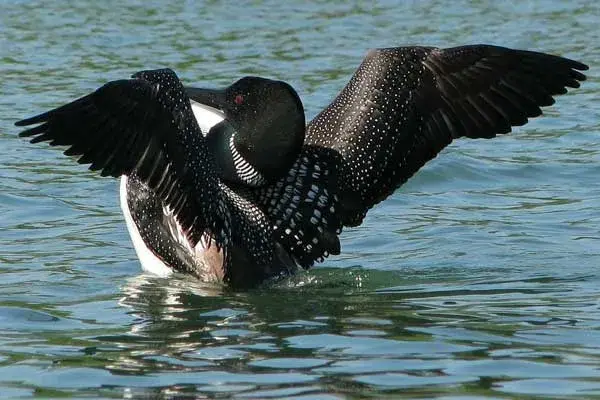
- Scientific Name: Gavia immer
Common loons are large diving waterbirds with rounded heads and dagger-like beaks.
During summer, adults are black above, white below, and have black heads and bills, and black-and-white spots on their backs. When the non-breeding season comes, the dramatic black and white colors will change into a winter plumage of dull dark gray with white on the front of the neck and breast.
Common loons can be seen in NYC during their nonbreeding season. The best time to see them there is around late fall when they are fairly common there. Gerritsen Creek, a freshwater creek in Marine Park in Brooklyn, is a great place to spot them.
Common loons breed in Canada, the Northern and Northeastern USA, and southern parts of Greenland and Iceland. After that, they migrate to their wintering grounds on both US coasts down to Mexico, and on the Atlantic coast of Europe.
Fun Fact: Common loons are excellent divers that can stealthily submerge without a splash to catch fish, go over 200 feet below the water’s surface, stay there for up to 5 minutes, and swallow their prey underwater.
2. Northern Gannet

- Scientific Name: Morus bassanus
Northern gannets are the largest gannet species in New York City. Adults measure from 34 to 39 inches long and have a massive wingspan of up to 71 inches.
These huge birds are mostly white with dark wingtips and cream-colored heads and necks – that color becomes more prominent during the breeding season. Identify them also by their long pointed beaks, wings, and tails.
Northern gannets are most common to see in NYC from late fall to spring. They spend most of their life at sea, but close to the land which means you might spot them from the shores.
Fun Fact: Northern gannets have an interesting way of hunting where they dive like a torpedo into the water to grab fish. Thanks to their sharp vision, northern gannets can detect prey underwater, and due to their eye adaptations, they can see well immediately after going underwater.
3. Double-crested Cormorant

- Scientific Name: Phalacrocorax auritus
Double-crested cormorants are large black water birds commonly found around bays, lakes, ponds, canals, and marshes.
Double-crested cormorants are permanent residents of NYC and you can easily see them there throughout the year. Gerritsen Creek is a great place to go looking for them.
They are the most widespread cormorant species in North America and can be recognized by their jet-black plumage, small heads, long necks, and thin, strongly hooked orange beaks.
Their most common call is a deep guttural grunt that resembles a pig oinking. When the breeding season starts, males will develop bushy white eyebrows (feathery tufts).
Fun Fact: Double-crested cormorants are excellent swimmers that can dive over 24 feet in depth and stay there for over a minute. However, since they do not have fully waterproof feathers, after hunting, they will stand on the shore with their wings spread to dry.
4. Great Blue Heron

- Scientific Name: Ardea herodias
Great blue herons are the largest species of heron in New York. They are gray-blue with black plumes on their head, and long orange beaks.
With a wingspan of up to 6.6 ft, these blue-winged birds are hard to miss. When flying, they will hold their neck in an S-shape with legs trailing behind.
Great blue herons are permanent residents of New York City, found year-round in marshes and pond edges. They are present in the city in the largest numbers from late fall to spring. Pelham Bay Park, Inwood Hill, and Forest Park are great places to see them there.
These wading birds will slowly stalk their prey in shallow waters and strike with lightning speed to catch them with their long and sharp beaks.
Fun Fact: Great blue herons are monogamous only for a single and these enormous blue birds nest in colonies called heronries that can occasionally have more than 500 nests!
5. Turkey Vulture
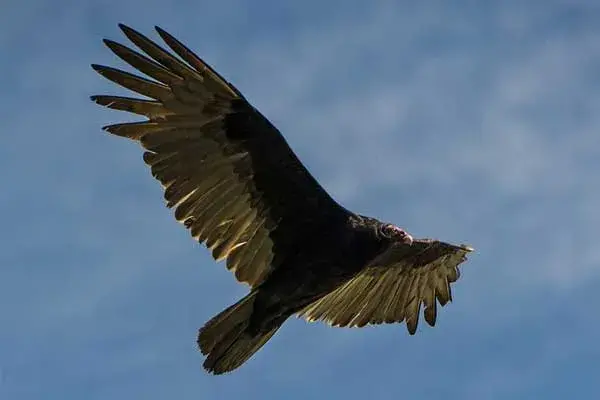
- Scientific Name: Cathartes aura
These big black birds are the most widespread of the New World vultures. Turkey vultures, also known as turkey buzzards, or just buzzards, got named for their resemblance to wild turkeys.
With a wingspan of around 6 feet, black-brown plumage, bare red heads, and white legs, turkey vultures are hard to miss in the sky. Look for their silvery flight feathers that are contrasted with dark wing linings while they fly.
Turkey vultures are permanent residents of NYC; the best time to go looking for them is during summer when they are the most common there.
They are one of the largest raptors in the USA, just after the eagles and condors. Some wildlife experts estimate a population of over 18 million turkey vultures in total.
Turkey vultures lack a syrinx (the vocal organ) which makes them voiceless; all they can do is hiss, whine, and grunt. They are very social birds that roost in large community groups with several hundred individuals.
Fun Fact: Because of their extremely strong stomach acids, turkey vultures can eat and digest carcasses tainted with anthrax, tuberculosis, and rabies, without getting sick. They do a great service across the US by removing dead animals and preventing the transmission of any diseases those dead animals could have carried.
6. Mallard
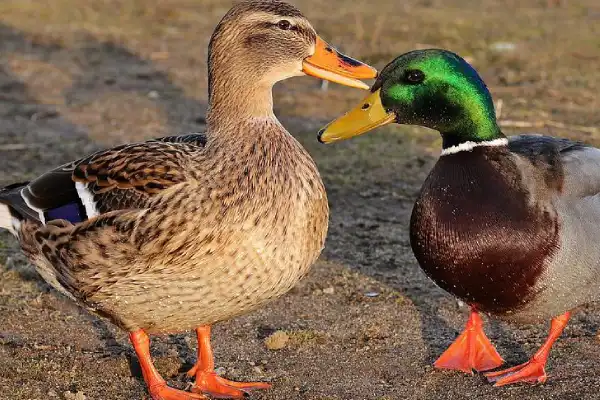
- Scientific Name: Anas platyrhynchos
Mallards are large ducks and the ancestors of nearly all domestic duck breeds.
You will find them near shallow ponds and lakes in NYC throughout the year. Look for mallards by the Van Cortlandt Lake in Van Cortlandt Park, in Prospect Park in Brooklyn, in Forest and Highland Parks in Queens, and Staten Island’s Clove Lakes Park.
They are easy to recognize as males have dark green heads and white collars while females and juveniles have mottled brown plumage with orange bills with brown spots.
Females make a duck-like quack, but males do not. Instead, they produce deeper, raspier one and two-note calls or rattling sound by rubbing their bills against their flight feathers.
Fun Fact: Mallards can fly fast and swim well – they have a 3 ft wide wingspan and can reach a top speed of 70 mph!
7. Ruddy Duck

- Scientific Name: Oxyura jamaicensis
Ruddy ducks are stiff-tailed ducks with stunning beaks.
These small North American ducks can be identified by their long stiff tails, short necks, black caps, and white cheeks.
Male ruddy ducks have rich chestnut plumage and bright blue scoop-shaped bills during summer. When the winter comes, they become gray-brown and their beaks become dull grayish-blue. Females and immatures have brown plumage, dark caps, and a dark line through their cheeks.
Ruddy ducks breed in marshy lakes and ponds. They are permanent residents of New York City but you will most commonly spot them there from winter to summer.
Ruddy ducks become very aggressive during the breeding season; they can be seen chasing away rabbits feeding on the shore close to them! When winter comes, these migratory ducks move to coastal bays and unfrozen lakes and ponds.
Fun Fact: Ruddy ducks have an interesting courtship ritual – male ruddy ducks will perform a “bubbling display” where they beat their bills against their chests in a rapid fashion, forcing air bubbles from their feathers.
8. Osprey

- Scientific Name: Pandion haliaetus
Ospreys are large diurnal birds of prey found on every continent, except Antarctica. Due to their small white heads, wide wingspans, and sharp beaks and talons, people sometimes mistake them for bald eagles.
Ospreys are white below, brown above, and overall they are whiter than most birds of prey. They also have M-shaped wings when soaring and white heads with a broad brown stripe through the eyes.
In North America, ospreys breed from Alaska and Newfoundland south to the Gulf Coast and Florida. When winter comes, they move south to winter from the southern parts of the USA to Argentina.
Ospreys are summer residents of New York City and are best seen there from spring to fall. The best time to see them there would be early fall. Hunter’s Island and the Lagoon in Pelham Pay Park are great for spotting ospreys, while the Marine Park also offers a chance to see these raptors looking to mate.
Ospreys are piscivorous and fish makes up 99% of their diet, hence their nickname “fish hawk.”
Fun Fact: During their 20-year-long lifetime, these migratory birds can travel over 160,000 miles!
9. Bald Eagle
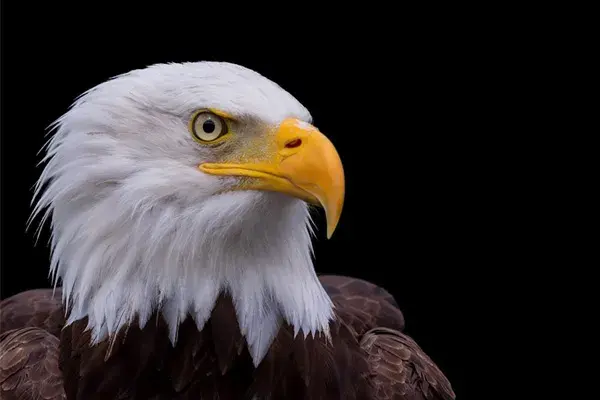
- Scientific Name: Haliaeetus leucocephalus
Bald eagles are the national birds of the United States. They are brown with white heads and tails and yellow legs. Before attaining these characteristics around the age of five, bald eagles are mostly dark brown with varying amounts of white mottling. They are most common around coastal areas and inland areas near water.
There are around 200 or 300 nesting pairs in New York but Florida has one of the densest concentrations of bald eagles in the US, with over 1,500 pairs found there.
Inwood Hill Park‘s forested area and location on the shores of the Hudson River are an ideal place for spotting bald eagles – they are best seen in NYC from fall to spring.
These magnificent raptors are hard to miss as they soar through the air with their 7.5-foot-wide wingspan. Bald eagles are carnivores and opportunistic feeders that primarily consume fish they snatch from the water with their sharp talons.
Fun Fact: Bald eagles build one of the largest nests of any North American bird – the largest recorded one was in Florida and measured 10 feet wide and 20 feet deep.
10. American Oystercatcher
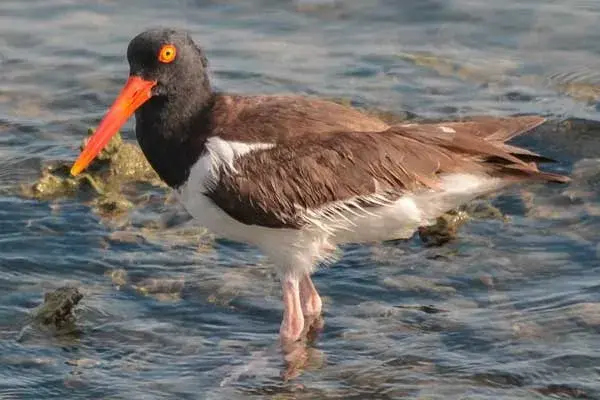
- Scientific Name: Haematopus palliatus
American oystercatchers are large shorebirds found on the beaches of the Atlantic and Gulf coasts.
They have black heads and breasts, grayish-brown backs, tails and wings, and white underparts. Their yellow eyes are edged with orange eye-rings. American oystercatchers also have long, bright orange beaks, around 3 inches long.
The beaks are razor-sharp and the birds use them to pry open oysters and other bivalves for food, hence the name “oystercatcher”.
American oystercatchers are permanent residents of NYC and can be seen there year-round – they are most common from spring to late fall.
During the breeding season, they inhabit sand or shell beaches, dunes, salt marshes, marsh islands, and mudflats; when the winter comes, they are common around shellfish beaches and mud and salt flats.
Fun Fact: Oystercatchers are social birds that live a rather laid-back life – they can be often seen during the day foraging, preening, resting, and sunbathing.
11. Ring-billed Gull
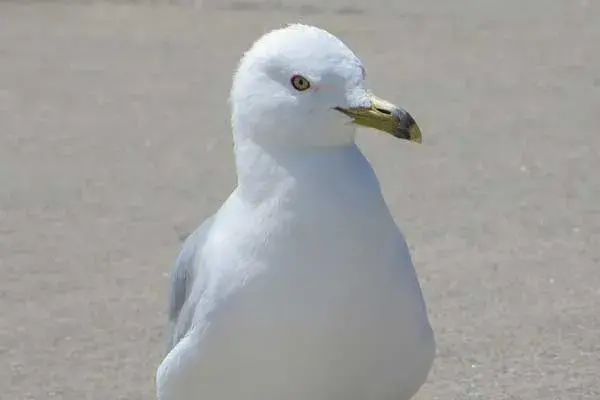
- Scientific Name: Larus delawarensis
Ring-billed gulls are medium-sized gulls with white bodies, gray wings, yellow eyes, and yellow legs. They got their name from the dark rings on their relatively short beaks.
Ring-billed gulls are permanent residents of NYC and are easy to see there throughout the year. Several gulls, including ring-billed ones, can be seen on the lakes in Clove Lakes Park, for example.
Ring-billed gulls are omnivores and also feed on insects, fish, grain, eggs, earthworms, and rodents. They will nests in colonies generally on small islands and lay three eggs that both parents incubate.
Fun Fact: They are often called the “fast food gulls” because they can be often seen around fast-food restaurants scavenging for food.
12. Mourning Dove

- Scientific Name: Zenaida macroura
Mourning doves are one of the most abundant and widespread North American birds; they are also very popular gamebirds.
They have light brown bodies, black spots on their wings, long tails, and iridescent necks. They can be also identified by their different vocalizations: distinctive “coo-woo-woo” calls when attracting females, soft greeting “ork” calls, and short “roo-oo” alarm calls.
Mourning doves are permanent residents of New York City and can be found around suburban yards and parks of the state throughout the year.
They are monogamous birds where both parents incubate the eggs and raise the young – mourning doves are excellent at breeding and can raise up to 12 young per year which explains their huge population.
Fun Fact: Mourning doves were named after the sad cooing sounds they make while singing.
13. Barred Owl
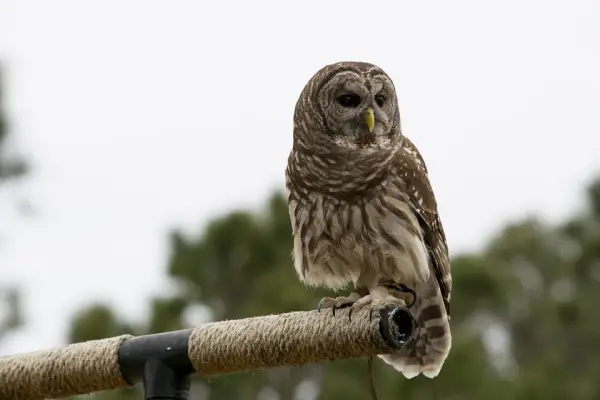
- Scientific Name: Strix varia
Known under several names (northern barred owls, striped owls, or more informally, hoot owls), barred owls are large birds with mottled brown and white plumage. They can be identified by their yellow beaks, the absence of ear tufts, and dark eyes.
They are native to eastern North America and are found mostly around woods and swamps where they hunt for insects, small mammals, crayfish, and crabs.
Look for barred owls in the highest points of Pelham Bay Park‘s oak forest, in North Woods of Central Park, and in Inwood Hill Park. You can best spot them there from fall to spring.
Barred owls will nest in tree holes or use abandoned nests of other animals, from red-tailed hawks to squirrels. After they establish nests, barred owls become very territorial and aggressive – they will chase away intruders by hooting aggressively or attacking them with their sharp talons!
Fun Fact: Barred owls will make hoots that sound like “who cooks for you, who cooks for you all” and that can be heard almost half a mile away.
14. Northern Saw-whet Owl

- Scientific Name: Aegolius acadicus
These small owls native to North America are often found around coniferous and deciduous forests.
With a length of 6.7-8.7 inches and a weight of 1.9-5.3 ounces, they are the smallest owl species in New York City. Look for them in the trees of Bronx’s Pelham Bay Park, Brooklyn’s Prospect Park, and Manhattan’s Central Park.
People often describe them as the “cutest owl species found in the northeast.” Northern saw-whet owls are mottled brown with white-spotted heads, whitish facial disks, yellow eyes, and lack of ear tufts.
These adorable owls with yellow eyes were named after their loud and repetitive whistles that are described as “a saw being sharpened on a whetstone”.
Strictly nocturnal and solitary, the species hunt at night from low perch and use sight and sound to locate their prey. Northern saw-whet owls are carnivores and mostly feed on mice, voles, lemmings, small birds, and some insects.
Fun Fact: Northern saw-whet owls have unique flight feathers due to a compound called porphyrin – the pigment gives their feathers a neon pink fluorescence when exposed to UV light.
15. Ruby-throated Hummingbird
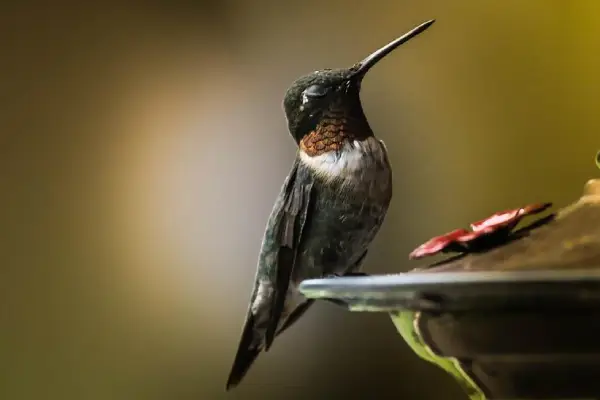
- Scientific Name: Archilochus colubris
Ruby-throated hummingbirds are the smallest birds in New York – they can weigh as little as 0.07 oz (less than a penny) and have a length of as little as 2.8 inches.
They have green upperparts, gray to white breasts, and black tail feathers with white outer edges. Males also have bright crimson gorgets (throats) while females have white throats.
Ruby-throated hummingbirds are summer residents of New York and are common around wood edges and residential areas. They stay in the city from April to late October, before migrating south for winter.
These birds are mostly solitary, except during the breeding season which lasts a few days. To attract these hummingbirds with red necks to your backyard, you can set up hummingbird feeders or plant tubular flowers. They are quite bold and might even feed at hanging plants and feeders on your porch or next to your windows!
Fun Fact: Ruby-throated hummingbirds move very quickly, around 25 mph, and will beat their wing over 50 times per second.
16. Downy Woodpecker
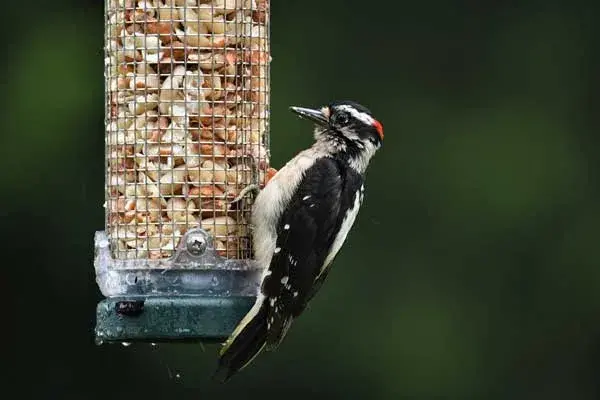
- Scientific Name: Picoides pubescens
Downy woodpeckers are the smallest woodpecker species in New York City and the entire North America. They measure as little as 5.5 inches in length and weigh as little as 0.7 oz.
Identify downy woodpeckers by their black upperparts and wings, white backs, throats, bellies, and white spottings on the wings. They also have one white bar above and below the eyes; adult males have red patches on the back of their heads.
Downy woodpeckers are permanent residents of NYC and can be seen in forests, parks, and gardens throughout the year. In case you happen to be in Manhattan, Fort Tryon Park is a great place to spot downy woodpeckers hanging around trees.
Downy woodpeckers are omnivores that primarily feed on insects, beetle larvae, ants, caterpillars, berries, acorns, and grains. You can also attract these tiny woodpeckers to your backyard by adding suet and black oil sunflower seeds to your feeder.
Fun Fact: Downy woodpeckers have special feathers around their nostrils to save them from breathing in wood chips as they hammer the tree bark.
17. Eastern Kingbird
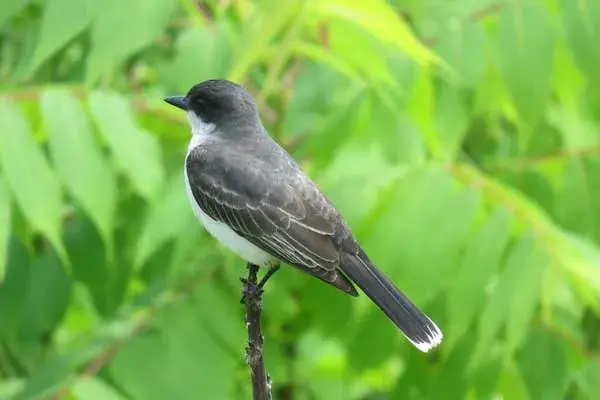
- Scientific Name: Tyrannus tyrannus
Eastern kingbirds are large flycatchers found in North, Central, and South America. They live in the open country, farms, and fields; areas that have bushes and scattered trees where they can perch while foraging for insects.
The name “kingbird” comes from the birds’ crowns. Eastern kingbirds also have dark gray-black plumage, white underparts, dark caps on their heads, and white bands at the tips of their tails.
Eastern kingbirds are breeding residents in NYC and can be most commonly seen there in late summer and early fall.
They will often sit perched on wires, watch for large insects, and make quick flights to snatch them. Eastern kingbirds also feed on berries and fruit, mainly during winter.
Fun Fact: Eastern kingbirds become very aggressive and territorial during their breeding season and chase away any bird that enters their territories, including large ones like hawks and crows.
18. Blue Jay

- Scientific Name: Cyanocitta cristata
Common around forests, woods, parks, and other urban areas with large oak trees, blue jays are rather small blue-colored birds.
They can be seen in New York City at any time of the year as they are permanent residents there. Look for them in the heart of Staten Island, at Greenbelt.
Males and females are alike and have lavender-blue color above and white color below. They also have black collars, white tails and throats, and blue wings with white spots.
On top of their head, there is a crest that can be used to indicate the birds’ mood – when agitated, the crest goes up and when frightened, the crest goes down.
They are very noisy make a large variety of sounds, may learn to mimic human speech, and can even use tools. Blue jays are not state birds in any US state but are mascots of Toronto Blue Jays, a Major League Baseball team.
Fun Fact: Blue jays will often mimic hawk sounds when approaching a feeding site to drive away other birds.
19. Yellow Warbler

- Scientific Name: Setophaga petechia
One of the most widely distributed birds across North America, American yellow warblers are small songbirds with medium-long bright yellow tails and rounded heads. Their bright and sweet song can be often heard near streamside willows and woodland edges across the United States.
In NYC, they are common from spring to fall. Freshwater wetlands of Clove Lakes Park and Central Park welcome yellow warblers each spring and make popular birding places to spot them.
After breeding across central and northern North America and spend winters in Central America and northern South America. Yellow warblers are diurnal birds and omnivores, feeding on insects such as leafhoppers, beetles, wasps, midges, and caterpillars, in addition to some berries and fruit during the winter.
Fun Fact: To attract females, male yellow warblers will produce over 3,000 whistling songs per day.
These birds are one of many common birds of Northern California.
20. Northern Cardinal

- Scientific Name: Cardinalis cardinalis
Northern cardinals are medium-sized songbirds found in Southeastern Canada, the Eastern USA, Mexico, and parts of Central America. They inhabit woodlands, gardens, shrublands, and wetlands.
These beautiful orange-beaked birds with stunning head crests are sexually dimorphic. Male northern cardinals are bright red with black throats and faces while the females are mostly brown with reddish wings and tails.
Northern cardinals are very common in NYC and can be seen there year-round.
These birds are also known as redbirds and they get their red color from the food they eat – if there are not enough carotenoids in their food, they become brownish.
Fun Fact: Northern cardinals are very territorial and aggressive – northern cardinals will often try to ferociously attack their reflections in the mirrors and windows.
21. Boat-tailed Grackle
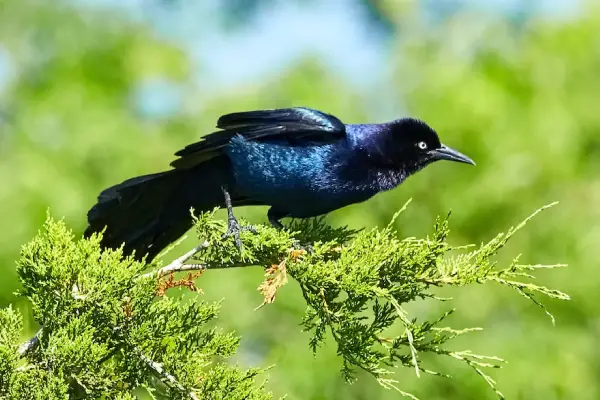
- Scientific Name: Quiscalus major
Boat-tailed grackles are large blackbirds found on the coasts of the Southeastern USA. They inhabit coastal saltwater marshes and breed in salt marshes, marshes along rivers, lakes, impoundments, or ponds, and in nearby upland habitats.
Identify male boat-tailed grackles by their iridescent black plumage, greenish-blue wings, keel-shaped tails, black downcurved beaks, and brown or yellow eyes. Females have brown plumage, darker wings and tails, and pale brown breasts – they are almost two times smaller than males.
Boat-tailed grackles are permanent residents of New York City and can be seen year-round there.
These rather noisy species are diurnal (active during the day) and gather in huge flocks to feed and roost. According to some estimates, boat-tailed grackles have a global population of around 3.7 million birds.
Fun Fact: Boat-tailed grackles are polygamous as males might mate with several females that build nests on their territories; females will also mate with male strangers from the colony.
22. Dark-eyed Junco
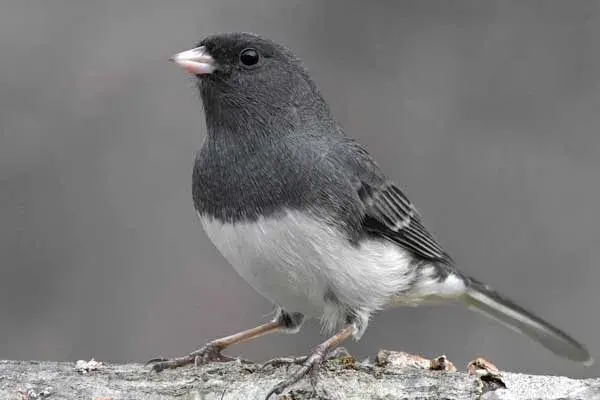
- Scientific Name: Junco hyemalis
Dark-eyed juncos are small songbirds that belong to a group of New World sparrows. There are around 15 recognized subspecies that all look similar and make taxonomists’ lives a misery.
Dark-eyed juncos can be recognized by their rounded heads, short beaks, and fairly long tails. They also have black plumage, white underbellies, dark heads, and pale beaks.
Dark-eyed juncos are one of the most common birds in North America that can be seen around woodlands, brushy fields, parks, and thickets. They are non-breeding residents of NYC and are most common during late fall and winter.
These tiny dark birds often forage while hopping and running on the ground and might even scratch the ground/snow with their feet in pursuit of food.
Fun Fact: Dark-eyed juncos are nicknamed “snowbirds” because they’re commonly sighted during winter.
23. Red-eyed Vireo
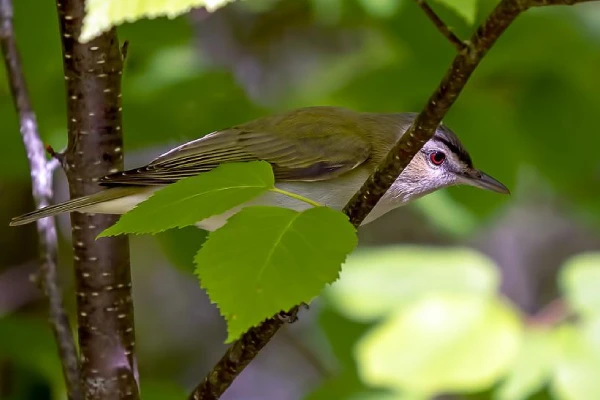
- Scientific Name: Vireo olivaceus
Red-eyed vireos are common songbirds that are olive-green above, dingy below, and have dark eye lines, light eyebrows, heavy beaks, and hard-to-spot red eyes.
Red-eyed vireos are summer residents of NYC and are best spotted in spring. Find red-eyed vireos in the shady woodland hillsides of Clove Lakes Park and in the Forest Park in Queens.
The first to arrive at the breeding grounds will be males to establish territories and form pairs shortly after the arrival of the females. After pairing, females will build the nests (males do not help) and lay a clutch of three to five spotted eggs. Both parents will feed the chicks.
These small songbirds are susceptible to brood parasitism – in one instance, scientists found one red-eyed vireo female incubating four eggs of other birds; there were no vireo eggs in its nest as the other bird had punctured or pitched out the vireo’s eggs.
These NYC birds are omnivores and usually feed on insects and berries. Males will feed in the high canopy, while females forage lower down.
Fun Fact: These tireless singers will usually sit high up in the trees and emit different sounds – scientists even recorded one red-eyed vireo singing 117 different types of songs!
24. Cedar Waxwing

- Scientific Name: Bombycilla cedrorum
Cedar waxwings are one of the most striking and handsome birds in the Northeast.
Their scientific name translates as “silk-tail” and refers to their silky-soft plumage. Cedar waxwings are medium-sized songbirds that have large heads and crests, black masks, and short necks and beaks.
They also have pale brown heads, soft gray wings, pale yellow bellies, and gray tails with bright yellow tips. If they consume a lot of honeysuckle fruits while growing up, the tips of their tails will turn from yellow to orange.
These yellow-tailed birds got their common name from the waxy red tips on their secondary wing feathers.
Cedar waxwings are permanent residents of New York City and are fairly common around wooded areas with access to water and berries.
Cedar waxwings are classified as songbirds but have no song. Instead, they use several short and simple calls, a high-pitched “bzee” and a sighing whistle.
Fun Fact: Cedar waxwings are one of the few North American birds that can survive eating only fruit for several months. Scientists recorded cases of them becoming drunk from eating too much of the fermented fruit.
25. Belted Kingfisher
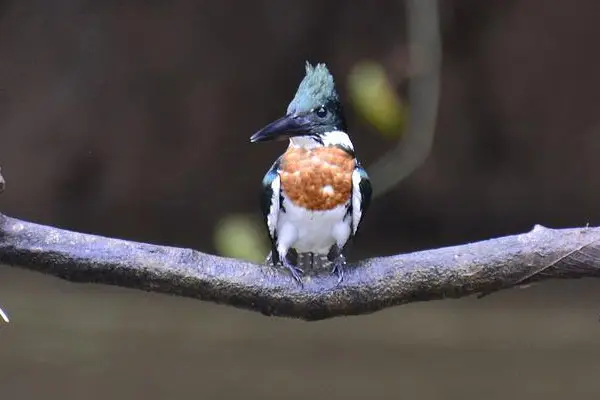
- Scientific Name: Megaceryle alcyon
Belted kingfishers are conspicuous water kingfishers that can be identified by their large heads, long and heavy beaks, and shaggy crests on top.
Males are slate blue with white underparts, while the females have orange patches on their bellies and flanks and are a lot brighter than males – brighter female plumage is not very common among birds.
Belted kingfishers can be also identified by their harsh mechanical rattles and scream calls. When the breeding season comes, they become very territorial – males will often charge at and chase intruders away.
Usually found along lakes, rivers, streams, marshes, and ponds, belted kingfishers are permanent residents of NYC. Inwood Hill Park is home to belted kingfishers together with Walker Pond and Loosestrife Swamp in High Rock Park.
Belted kingfishers are carnivores that dive to catch fish and crayfish with their heavy beaks; they also feed on mollusks, crustaceans, amphibians, and lizards.
Fun Fact: Belted kingfishers can’t digest bones, so just like owls, they regurgitate the undigested food pieces as pellets.
Read More: 20 examples of common birds in Baltimore
More Examples Of Birds In New York City
- Red-throated Loon
- Pied-billed Grebe
- Horned Grebe
- Great Cormorant
- Great Egret
- Snowy Egret
- Tricolored Heron
- Cattle Egret
- Black-crowned Night-Heron
- Glossy Ibis
- Snow Goose
- Canada Goose
- Brant
- Mute Swan
- Wood Duck
- Gadwall
- Canvasback
- Redhead
- Northern Harrier
- Sharp-shinned Hawk
- Broad-winged Hawk
- Red-tailed Hawk
- Rough-legged Hawk
- American Kestrel
- Merlin
- Peregrine Falcon
- Gyrfalcon
- Ring-necked Pheasant
- Wild Turkey
- Northern Bobwhite
- Clapper Rail
- Virginia Rail
- Sora
- Common Moorhen
- Black-bellied Plover
- Semipalmated Plover
- Piping Plover
- Killdeer
- American Crow
- Fish Crow
- Horned Lark
- White-breasted Nuthatch
- Red-breasted Nuthatch
- Tree Swallow
- Bank Swallow
- Cliff Swallow
- Barn Swallow
- Northern Mockingbird
- Black-capped Chickadee
- Tufted Titmouse
Summary
This concludes our list of birds in New York City. It included species that can be seen in 5 boroughs of the city – feel free to use it as a checklist in case you go birdwatching in NYC.
And if you want to learn more about birds found in upstate New York, check out this article.